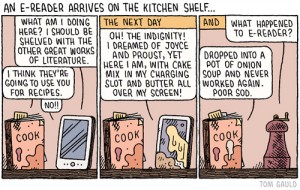I’m currently sat here in Café W Brighton drinking my flat white and debating the inevitable future bookstores may soon face. It’s hard to believe that thess brick and mortars may one day be extinct. The data all points towards the digital upheaval taking away from physical bookstores ability to remain financially sustainable. I however am not convinced of such a future; I am currently sat next to a French couple enjoying a cup of coffee and browsing the cookery section. On the floor below colouring, sparkles and the sound of little kids ravaging through books. I am surrounded by linguists, fashion entrepreneurs, mothers to be, teenagers who want to be anywhere but here and content elderlies indulging a great book and eating cake.
So why must it all come to end lets have a look at what the academics and bloggers have to say.
5 Reasons to Contemplate the use of Electronic Books:
1.) The ever-increasing problems associated with publication rates of both paper and electronic documents.
2.) Limitations imposed by rates at which humans can read text-based material.
3.) Implications of media competition.
4.) Speed and accuracy with which electronic material can be accessed.
5.) The ways electronic material can be re-organised in dynamic ways to achieve more flexible presentation and access.
– (Barker, P. (1998)
The Future of Books in 7 Easy Steps:
1.) Amazon will continue to grow forcing booksellers to downsize.
2.) Companies with weak financial capabilities will face difficulties.
3.) The decline of retail space in bookstores will make it harder for publishers books to be noticed.
4.) The shift from print to digital (e-books and other electronic sales) will become publishers significant source of revenue.
5.) More sales shift to digital sales and physical books will start to decline.
6.) Infrastructure supporting the traditional book supply chain – warehouses will come under increasing pressure.
7.)Small publishing operations and innovative start-ups will proliferate.
- (Thompson, J. (2012)
This blog post in Huffington was written in 2012 from what we can deduce after the closing of Borders Bookstore the future of other book retailers seemed doomed. Waterstones followed suit with almost every prediction that was made, facing financial devastation and almost bankruptcy. However Book sales actually picked up and the sales of e-readers such as kindles began to decline pushing them out from Waterstones shelves.
The matter of the fact is, that although everyone has predicted the digital shift would have a significant effect on physical books stores (and it has) the effects weren’t as detrimental predicted. There is a large population of people who will always love the idea of going into physical bookstores. If anything what we have learnt from operating in this volatile period is that book retailers have an extremely loyal consumer basis.
A blog post written by Sarah Convissar expresses my exact same feelings towards digital technologies replacing books.
The most likely outcome is this situation is that yes we will continue to see a decrease in physical bookstores as online giants such as Amazon continue to gain market share. However I don’t believe this means all is lost there will still be a strong consumer portfolio supporting the want and need for book retailers as proven by Waterstones come back despite the financial recession and digital shift. There is one thing that Amazon will never be able to create through there online books sales and that is customer experience.
References
Barker, P. 1998, “The future of books in an electronic era”, The Electronic Library, vol. 16, no. 3, pp. 191.
Thompson, J. (2012). Where Is Publishing Headed?: The Future Of Books In 7 Easy Steps. Available: http://www.huffingtonpost.com/john-b-thompson/future-of-books_b_1501182.html. Last accessed 26th March 2016.

